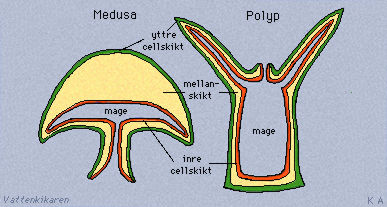|
|
|
Polyps and medusae

Cross section of a cnidarian.
There are two basic forms of cnidarians:
free swimming
medusae and attached polyps. Certain
cnidarians can change between these forms, while others are either
medusae or polyps all their life.
Cnidarians can be found in varying sizes, from a microscopic
polyp, to the largest jellyfish,
that can be 2 metres over the "umbrella" and with tentacles over 30 metres
long. They can live a solitary existence or in colonies
with many other individuals. Coral
reefs are composed of a great many cnidarian colonies and can cover
large areas of the sea-floor.
Cnidarians are found only in a Marine environment, some
of which in freshwater, but mostly in seawater.
Two layers
The anatomy of the cnidarian is of a very
simple nature. It consists of two layers, an outer (ectoderm) and an inner
(endoderm). The inner layer is basically built like a sac and of the same
form as the outer. It is within the walls of these two layers that the
stinging cells, muscles and nerves are found aswell as where digestion
takes place. Between these two cell layers is a layer of jelly or fibre
(mesoglea), that contains hardly any cells. The mesoglea gives the animal
its form. The mouth of the cnidarian is situated in the middle of its
round body. It
is here food is inserted and the undigested remains are ejected. The
stomach can be very branchy and this can aid the transport of nourishment
within the animal. The tentacles are commonly found around the mouth.
|

|
Page 3
of 13
|

|
|